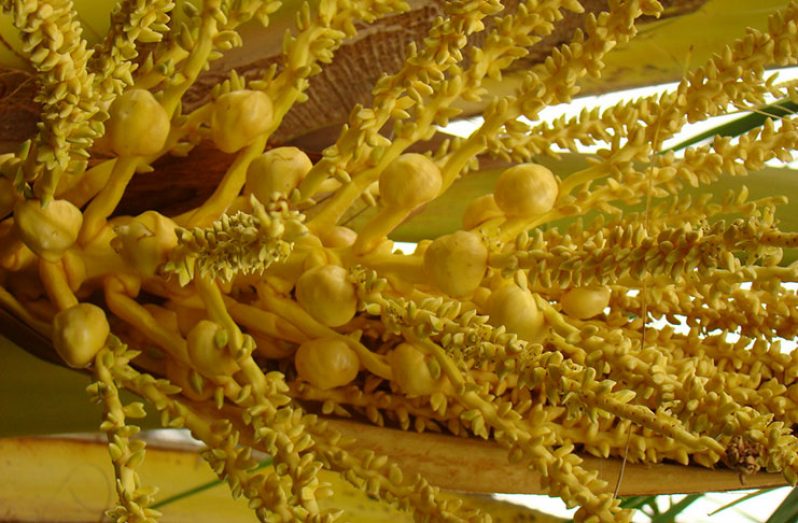
Are you thinking about setting up a coconut farm but lack relevant information to kick start your venture? Well, the following facts will be helpful to you. This factsheet contains:
1. Soil Type: Coconut is grown under different soil types such as loamy, laterite, coastal sandy, alluvial, clayey and reclaimed soils of the marshy low lands. The ideal soil conditions for better growth and performance of the palm are proper drainage, good water-holding capacity, and presence of water table within 3m and absence of rock or any hard substratum within 2m of the surface.
2. Germination: The ripe fruits that fall do not germinate immediately and, if dried during storage, they lose the capability. Coconut seednuts germinate easily in warm, humid conditions and sprout and grow naturally wherever they fall. About 3-6 months after the nut matures, the embryo begins to enlarge internally, eventually filling the cavity with a sponge-like haustorium. This produces the enzymes that convert the oil in the kernel into nutrients that are absorbed to support early plant growth. Within the husk, the growing point of the embryo develops a plumule and young root, which eventually emerge through the mesocarp and exocarp and expand in daylight for photosynthesis to begin. The time taken for emergence depends on the thickness of the husk.
3. Mature fronds: The period from unfolding to growth and drying of the leaf can be about 27 months. The young leaf which protrudes out of the bud in the centre of the crown as a pointed arrow takes about 4 to 5 months to emerge out of the sheath. The length of leaves is influenced by factors such as variety, soil, climate and age of palms. A quarter of the total length of the leaf is the leaf stalk. The number of leaflets on a leaf varies from 200 to 250.
4. Stem: The stem develops from the single terminal bud called the “cabbage” which is the only vegetative growing point of the palm. Under favourable conditions, the foundation of the trunk of a young palm reaches full development within three to four years. Stem growth is faster at the early stages, which can be as much as 1.5m per year becoming slower in older palms and decreasing to 10cm – 15 cm per year at the 40th year and over. The palm can grow up to 30m in height in very old trees. Height growth varies according to age, cultivar and ecotype and can be assessed by counting the number of leaf scars per metre. At about 10 years old, growth is around 15 – 30 cm per year for Dwarf palms and 70 – 100 cm per year for Tall palms.
5. Root system: The root system is adventitious and numerous uniformly thick roots are produced from the base of the stem throughout the life of the palm. There are no taproots or root hairs but the palm has numerous roots which bear large quantities of rootlets. The main roots are found within the topsoil. Roots of an adult-bearing palm growing in sandy loam soil are concentrated within a radius of 2m from the base of the palm and can grow up to 30 – 120 cm in depth. The main branches may grow deeper and extend laterally to as much as 104m, seeking out moisture. The numbers of roots vary from 4,000 – 7,000 in mature palms.
6. Flowering: The age at which the palm flowers varies according to the variety and management practices. Those having faster rates of leaf production and are grown under good nutritional and water management tend to flower earlier. Flowering generally begins at 2.5 years after planting out for Dwarfs and 7 years for Tall types. Once flowering has begun, the tree continues to produce flowers and fruits throughout the life of the palm.
The palm is monoecious, i.e. its inflorescence carries both male and female flowers. The male flowers are the first to open, beginning at the top of each spikelet and proceeding towards the base. Each male flower sheds its pollen and abscises in just one day but the entire male phase of pollen-shedding lasts about 20 days in most palms depending on season and variety.
A normal inflorescence may have 10-50 female flowers. These remain receptive from one to three days. Depending on the environmental conditions and variety, the female phase may begin a few days after the spathe has opened and lasts 3-5 days in Tall palms and about 8 – 15 days in Dwarfs.
With natural pollination, 50 – 70% usually aborts and falls off, especially those which, emerge during severe dry weather. The remaining flowers develop into fruits, which take about 12 months to mature. The length of the male and female phases is affected by climatic environment and usually do not overlap in the tall types, such that self-pollination rarely occurs. In some Dwarfs, particularly the Malayan Dwarf, overlapping of the male and female phases and between spadices usually takes place, promoting self-pollination. Hence, these Dwarfs are reasonably homozygous. (Contributed by NAREI)



.jpg)








